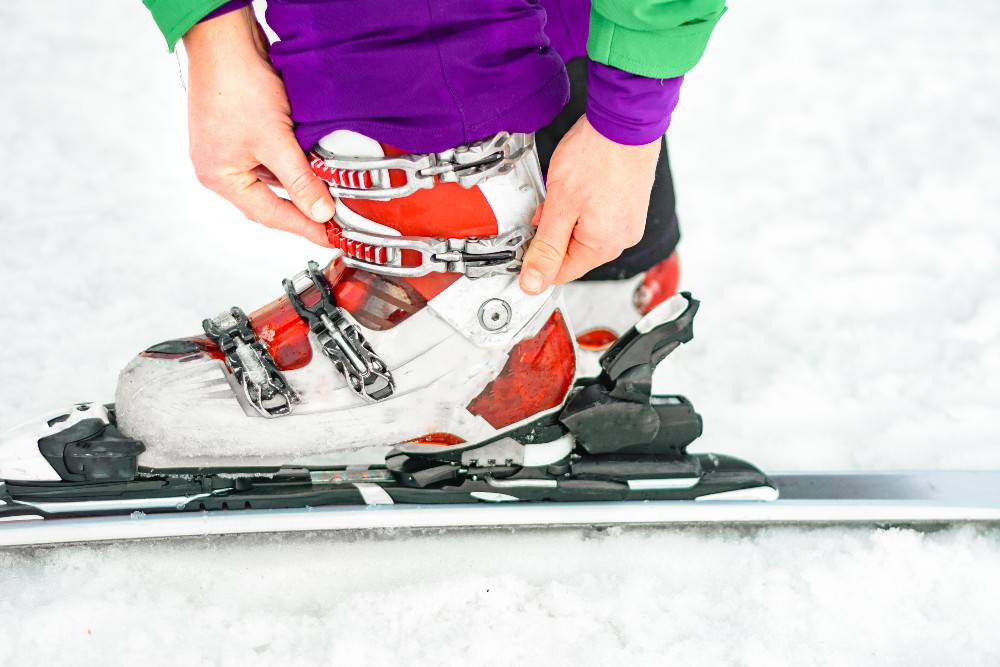Avoiding Foot and Ankle Sports Injuries on the Ski Slopes
Whether you prefer skiing or snowboarding, Colorado Springs is blessed to be near some of the greatest slopes this side of the States. You could spend a weekend out at Breckenridge, Monarch, or even take a day attacking the powder somewhere a bit closer.
Whatever your plans may be, the last thing anyone wants is for a miserable foot or ankle condition to pop up to make the weekend a wipeout.
As fun as it is carving through the white, it’s all too easy to make a mistake and put a damper on your time enjoying the best sports Winter has to offer. From simple ailments like cold feet that distract from the fun to a truly nasty sprain or fracture that sends you packing, you want to take measures to keep yourself safe and comfortable.
The good news is that there are things you can do to help lower your risks of painful sports injuries — just remember that we can’t really help you mitigate a direct collision with a mountain, though.
Be careful out there!
Here are some of our favorite foot care tips when it comes to conquering the slopes:
Always Keep Your Feet Warm to Avoid Sports Injuries
Let’s start off with a relatively common nuisance we can all relate to in one way or another: cold feet. Now, we can’t give you advice on going through with your latest commitment, but when it comes to keeping those piggies warm and cozy, we know a few things.
In most cases, cold feet are a nuisance at worst. However, when conditions are deeply chilled — or additional factors come into play — frostbite can become a serious concern.
For handling everyday cold weather on the slopes, your footwear is your best friend. Though most ski and snowboard boots are designed for warmth, the right socks will keep you from a winter sports injury like frostbite.
Choosing the Right Socks
Look for a sock that is not only designed for warmth, but for wicking moisture away from the feet as well. Keeping moisture against the feet helps them get cool faster, not warmer — and moist feet just feel terrible.
Wool is certainly a great material to look for, but certain synthetic options can keep your tootsies toasty as well. Just be sure to ditch those cotton socks. They’re simply not ideal at all.
For when temperatures dip further, consider adding sock liners for extra protection. They are thin and built to slip easily within your favorite boots for some added warmth.
Do not slip on an extra pair of socks over the pair you’re currently wearing, though. Not only will this lead to uncomfortable bunching up, but your foot is more likely to slip within your boots. This creates blister-causing friction and more frequent foot and ankle injuries.
Using Thermal Packets
Warming devices (like those little chemical packets) can also be of good use, but you may not be getting as much benefit out of them as you think. If you’re applying them directly to the spot you feel is coldest, you’re taking away from the rest of your body and using more than you need.
Think of your circulation instead. Try keeping your thermal packets in places that will keep circulation in your feet more open and warm. From the inside of the ankle, behind your knee, or even against your lower back, there are many ways to use these packets to keep your whole body warm and help prevent winter sports injuries.
Regardless of the precautions you take, if your toes or feet start to feel tingly and numb, then it’s time to take a time out. Stop what you’re doing and head to the lodge to warm up. Keeping your feet exposed to the cold at this point is risking frostbite and other foot injuries.
Make Sure Boots Are the Right Fit Help Avoid Foot and Ankle Sports Injuries
Your boots are the interface between you and your board or skis. They should not only help you control your equipment but also keep your feet and ankles from becoming too strained while doing so.
Boots that are too loose will allow the foot to slide around more than normal, which can lead to nasty blisters and tough calluses. They will also provide too little support to the ankles, increasing the risks of injury in falls or taking turns too quickly in the powder.
On the other hand, boots that are too tight can keep your toes crammed together like a tin of sardines. Not only will this increase the likelihood of blisters again, but it also promotes ingrown toenails and even corns. Cramped boots can also interfere with circulation to your feet, making it all the easier for them to grow dangerously cold.
Take a page from Goldilocks and invest the time to find your perfect pair. A boot that fits well will allow you some room for wiggling your toes, but also keep your heel firm and steady.
Renting some boots for a quick run down the mountain? Take your time. Don’t be in a rush to find the first pair of boots that are “good enough.” They’re not bowling shoes; you’ll likely be spending all day doing some strenuous stuff in those things!
Find the best fit and your day will be a lot better for it.
Suffering From a Black & Angry Toenail?
You might know this as “skier’s toe” or “toe bang,” but we know it in the podiatry office as “subungual hematoma.” This is when bleeding takes place beneath the toenail, causing it to turn black and ache like never before.
This condition happens when the front of your foot smashes against the inside of your boot, causing bleeding that becomes painfully trapped beneath your toenail. Boots that don’t fit well will increase your risk of this happening, but so can leaning back too hard while heading down a slope — a frequent beginner’s error.
If you suffer a subungual hematoma, you will want to drain the blood as soon as possible. Do not attempt this yourself — you might cause even more damage. Instead, seek professional help immediately. You can often find someone at the mountain itself, so don’t wait for the pain to become unbearable.
Take Care of Problems BEFORE You Hit the Slopes
While you can prepare for a happier and more worry-free trip on the slopes, some of the best actions you can take to prevent winter sports injuries can be tackled well before your boots strike the powder.
For instance, if you are already experiencing persistent foot or ankle discomfort, it’s best to start addressing it as soon as possible. Before it becomes a major pain that destroys your weekend on the slopes.
If getting your boots on is a bother due to a developing bunion or stiffness in your toe, for example, that’s something you should absolutely not wait on addressing now.
Bunions can lead to incredible discomfort throughout your entire foot with sharp pains that can suddenly attack you when you least expect it. And when you’re speeding down the slopes, the last thing you need is distracting pain stealing your attention away from a potentially deadly section of the mountain.
Contact Us for Help With Winter Sports Injuries
Whether you’re facing discomfort before or suffering after a nasty winter sports injury, we can help you eliminate and manage problems so they don’t ruin a beautiful weekend in the mountains.
At McVay Foot & Ankle, our focus is to get you the unique, personalized, and effective treatment options you deserve and to bring you better health.
Don’t let a little discomfort become a major pain.
Schedule an appointment at our Colorado Springs office by calling (719) 266-5000, or fill out our online contact form and make that weekend on the slopes an incredibly memorable — and comfortable — adventure.
© McVay Foot & Ankle. All Rights Reserved
Web Design by CP Solutions
Marketed by VMD Services
Privacy Policy | Terms & Conditions

